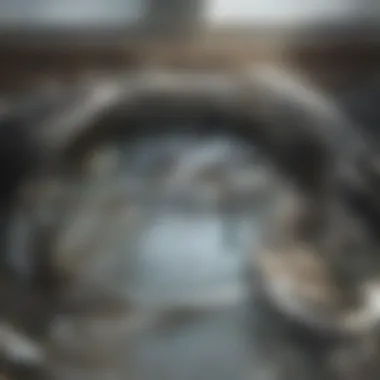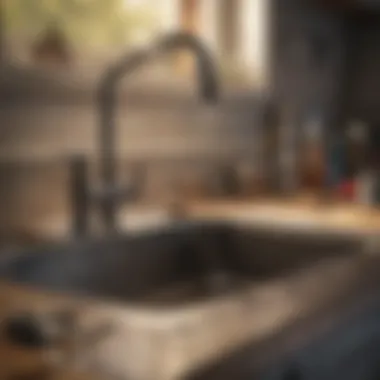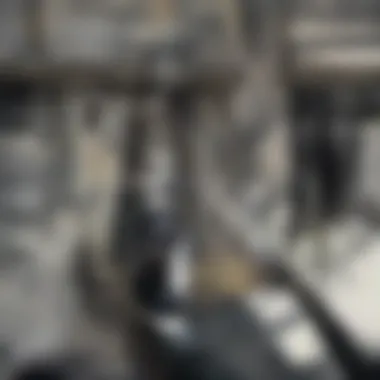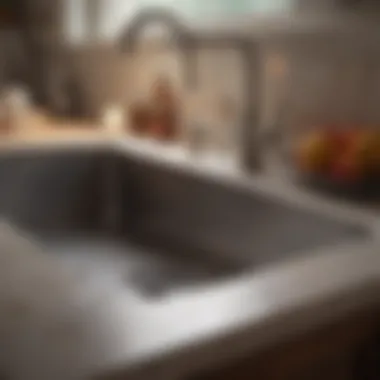How to Fix My Kitchen Sink Drain: A Comprehensive Guide


Intro
Dealing with kitchen sink drain issues is a common problem in many households. Homeowners often find themselves frustrated when water does not flow as it should. This guide aims to equip readers with detailed knowledge and practical solutions on how to address these concerns effectively.
Understanding kitchen drain systems is essential for troubleshooting problems. Most kitchen sinks are connected to a plumbing system that includes traps, pipes, and sometimes, garbage disposals. Each part can be a potential source of blockage or malfunction. Readers will not only learn how to fix current issues but also gain insights into preventative measures.
Common Drain Problems
Clogs and Blockages
Clogs are the most prevalent kitchen drain issue. They can be caused by food scraps, grease buildup, or foreign objects inadvertently dropped into the sink. When a clog occurs, water usually drains slowly or not at all.
Leaks
Leaky drains can result from worn-out seals or damaged pipes. A leak can lead to water damage under the sink and a significant increase in water bills.
Slow Drainage
A sink that drains slowly but does not appear to be clogged may indicate a deeper issue in the plumbing system, such as a partially blocked pipe.
Tools Needed
Before beginning repairs, gather these important tools:
- Plunger
- Pipe wrench
- Bucket
- Adjustable wrench
- Drain snake
- Towels or rags
Having the right tools on hand can make the process much smoother.
Step-by-Step Repairs
Diagnosing the Issue
Start by determining the nature of the problem. Look for visible signs like water pooling or slow drainage. It helps to run hot water down the drain to see if there is any change.
Clearing Clogs
To clear a basic clog, use a plunger. Ensure there is enough water in the sink to cover the rubber part of the plunger. Make several vigorous up-and-down motions to create suction and force the debris through.
If this does not work, consider using a drain snake. Insert the snake into the drain and turn the handle to break through or pull out the clog.
Fixing Leaks
Inspect the pipes under the sink for any visible leaks. Tighten any loose connections using the adjustable wrench. If the leak persists, you might need to replace washers or seals in the connections.
Preventative Measures
Maintaining your kitchen sink can help prevent future issues:
- Avoid putting grease or large food particles down the drain.
- Regularly flush the drain with hot water.
- Use a strainer to catch food scraps.
Regular maintenance can save you time and money in the long run.
The End
Understanding how to address kitchen sink drain issues is an invaluable skill for homeowners. With the proper tools and knowledge, many problems can be resolved easily. Remember, it is essential to also consider preventative measures for effective long-term maintenance. Whether dealing with clogs, leaks, or slow drainage, following the guidelines provided will empower you to manage your kitchen drainage needs effectively.
Understanding Kitchen Sink Drain Systems
Kitchen sink drain systems are crucial for any home. They provide a smooth way for wastewater to exit the kitchen, ensuring hygiene and function. Without an understanding of these systems, homeowners may struggle with common issues like clogs or leaks. Knowing how the system works can empower you to diagnose problems quickly and effectively. It can save time and money when issues arise. Moreover, an efficient drain system contributes to the overall value of the property, making it essential for real estate enthusiasts and home maintenance aficionados.
Components of a Kitchen Sink Drain
A kitchen sink drain comprises a few critical components:


- Sink Drain: This is the initial part where the water exits the sink.
- P-Trap: A curved segment of pipe that traps a small amount of water, preventing sewer gases from coming back into the home.
- Drainage Pipe: This pipe carries wastewater from the P-trap to the home’s main sewer line.
- Vent Pipe: This allows air to enter the drainage system to maintain proper pressure, ensuring smooth drainage.
Understanding each part’s role helps in identifying issues. For instance, knowing how the P-trap works can assist in understanding what happens during a clog.
How Kitchen Sink Drains Function
The kitchen sink drain operates on a simple principle. Water flows down through the sink drain into the P-trap. The water in the P-trap prevents odors from the waste system from entering the kitchen. From the P-trap, the water travels through the drainage pipe and into the home's sewer line.
This system relies on gravity and proper venting to function effectively. If any component fails, it can lead to problems such as slow drainage or unpleasant odors. Understanding these functions can aid in taking appropriate measures when issues arise.
Common Drain Problems
Several issues can occur within kitchen sink drain systems. Recognizing these problems early can save you from more extensive repairs later.
- Clogs: These are the most frequent issues. Food debris, grease, and soap can accumulate and obstruct water flow.
- Leaks: Often occur in the pipe connections or the P-trap. They may not always be visible, leading to water damage over time.
- Slow Drainage: Indicates that water is not flowing efficiently. This issue can suggest a buildup in the pipes.
- Unpleasant Odors: Often a sign of stagnant water in the P-trap or blockages causing waste to accumulate.
Recognizing these signs and understanding their causes will equip you well for the upcoming discussions on identifying issues and repair techniques.
Identifying Issues with Your Sink Drain
Understanding how to identify issues with your sink drain is crucial for any homeowner. Drains are often taken for granted, but they play an essential role in the functionality of your kitchen. When problems arise, it is important to recognize symptoms early. This can save time, effort, and money. Tending to drain issues promptly can prevent larger problems that may require professional intervention.
Slow Drainage: Causes and Remedies
Slow drainage is a common problem in kitchen sinks. It can be caused by a variety of factors. Grease buildup, food particles, or foreign objects can obstruct the pipe. Over time, mineral deposits can also accumulate in the plumbing.
To address slow drains, start by inspecting the drain. If you notice that water is taking longer than usual to empty, consider these remedies:
- Use a plunger to loosen the buildup. Ensure there is enough water in the sink to create a seal before plunging.
- Baking soda and vinegar can be effective as a natural remedy. Pour baking soda down the drain, followed by vinegar. Allow the mixture to bubble and work for about 15 minutes, then flush with hot water.
- If these do not work, a drain snake might be necessary. Run the snake down the drain to physically remove the blockage.
Clogs: Symptoms and Diagnosis
Clogs manifest in various ways. Slow drainage can signal a clog but is not always the only indication. Other symptoms include gurgling sounds when using the sink or water backing up into the basin.
To diagnose a clog, observe:
- Water behavior in the sink and any adjacent fixtures. If multiple areas are affected, this might indicate a larger plumbing issue.
- Check the trap underneath the sink. It may be necessary to remove it and look for obstructions directly.
Leaking Drains: Investigation Techniques
Leaks often occur at the joints or seals within the piping. Identifying a leak can be tricky. Look for water pooling under the sink or dampness on cabinetry. Once a leak is suspected:
- Examine the plumbing for visible signs of moisture. Pay close attention to the joints and connections.
- Use tissue to check for wet spots. This can help isolate the source.
- If the leak is not apparent, consider using a camera inspection tool to get a clear view of the pipes.
Unpleasant Odors: Sources and Solutions
Unpleasant odors are often a result of decaying food particles trapped in the drain. Foul smells can make the kitchen uninviting. To diagnose the source of the odor:
- Analyze the smell. A rotten, sewage-like odor may indicate a serious clog.
- Employ baking soda and vinegar as a remedy here as well. This method not only eliminates minor clogs but can also neutralize odors.
If odors persist, you may need to:
- Check and clean the traps regularly. This is essential in preventing buildup.
- Regular maintenance is key to keeping your drains fresh.
Remember to address these issues as they arise. Early detection ensures a smoother and more efficient kitchen experience.
Tools and Materials for Drain Repair
When it comes to fixing your kitchen sink drain, the right tools and materials are essential for success. Having the proper equipment can make a challenging job more manageable and ensure a more effective repair. Homeowners often overlook this crucial aspect, leading to frustration and potentially worsening plumbing issues. This section outlines the necessary tools and materials, their benefits, and considerations to keep in mind when dealing with drain repairs.
Essential Tools for the Job
To tackle any kitchen sink drain problem, certain tools are indispensable. Here are some key items you should have:
- Plunger: Often the first line of defense against clogs. A plunger can efficiently create suction to dislodge obstructions.
- Drain Snake: A flexible tool designed to reach deep into pipes and clear stubborn blockages. It’s especially useful for more severe clogs that a plunger cannot handle.
- Pipe Wrench: Essential for loosening or tightening pipe fittings. A good pipe wrench provides the leverage needed to deal with stubborn nuts and bolts.
- Flashlight: A bright light helps you see into dark spaces under the sink. It can reveal where leaks emanate from or aid in identifying clogs.
- Adjustable Wrench: Versatile and perfect for gripping and turning a wide array of fasteners, making any plumbing adjustment easier when repairing.


Having these tools on hand ensures you are well-prepared to address most common drain issues effectively.
Effective Drain Cleaning Supplies
Cleaning supplies are equally critical in maintaining and repairing kitchen sink drains. Consider these effective options:
- Baking Soda and Vinegar: This natural solution can clear minor clogs and odors. Adding baking soda followed by vinegar can create a foaming reaction that loosens debris.
- Chemical Drain Cleaners: While these can be effective, use caution. They often contain harsh chemicals that may damage your pipes if used excessively.
- ** enzymatic Cleaners**: These are generally safer and break down organic matter in drains without harsh chemicals. They are ideal for regular maintenance.
- Wet/Dry Vacuum: A powerful vacuum can efficiently remove debris from sinks and pipes, especially when water is involved. This tool is perfect for large-scale cleanups.
Utilizing the appropriate cleaning supplies can often prevent larger issues, saving you time and money in the long run.
Protective Gear for Safety
Safety should always be a priority when undertaking any repair work. The right protective gear helps mitigate risks:
- Gloves: Using heavy-duty rubber gloves protects your hands from chemicals and dirt while also providing better grip.
- Safety Goggles: Protecting your eyes from splashes and debris is critical, especially when using chemicals or working with plumbing fittings.
- Face Mask: To filter out any particles or fumes during cleaning processes, especially if you are using chemical cleaners.
Investing in protective gear prevents injuries and reduces exposure to potentially harmful substances. This is particularly important when working in tight spaces or with corrosive substances.
By preparing adequately and ensuring you have the right tools, materials, and safety measures in place, you will increase the likelihood of successful drain repairs, ultimately contributing to a more efficient kitchen.
Repair Techniques for Common Drain Issues
Repairing kitchen sink drains is essential in maintaining a funcional home environment. Proper repair techniques minimize long-term damage and avoid potentially costly repair services. Understanding these techniques empowers homeowners with the knowledge to tackle minor problems on their own, leading to a more efficient and manageable kitchen.
Clearing a Clogged Drain
Using a Plunger
Using a plunger is a primary method for clearing clogs. Its straightforward design enables quick resolution for many common blockages. The key characteristic of a plunger includes its rubber suction cup, allowing for effective pressure application.
This technique is beneficial because it requires minimal tools and no harsh chemicals, making it a safe choice for regular use. A unique feature is its ability to create suction and push debris through the pipe without risking damage. However, its effectiveness may be limited with more severe blockages.
Employing a Drain Snake
Employing a drain snake can provide a more thorough solution for tougher clogs. This tool features a flexible metal coil capable of navigating bends and traps in pipes. The core advantage of a drain snake is its effectiveness in removing stubborn blockages that a plunger cannot reach.
This technique is beneficial for its capacity to physically dislodge debris, such as hair, grease, and other materials. While using a drain snake does involve a bit more effort than a plunger, its unique ability to reach deeper into the plumbing system makes it a worthwhile option. Disadvantages include the learning curve for proper use and potential damage if mishandled.
Solutions with Chemical Cleaners
Chemical cleaners offer another method for addressing clogged drains. These products can effectively dissolve organic materials that contribute to blockages. The key characteristic is their active ingredients designed specifically for drain cleaning.
Chemical solutions are popular due to their convenience and effectiveness in some cases. They often require less physical effort compared to manual tools. However, these cleaners can pose risks to plumbing systems if used excessively and may harm the environment. Caution is needed with proper application and disposal.
Fixing Leaky Pipes
Identifying the Source of the Leak
Identifying the source of a leak is a pivotal first step in addressing leaky pipes. This process often involves looking closely at connections and joints to detect moisture or water damage. The key characteristic of identifying leaks is thoroughness. It requires observation and sometimes the use of specific tools to accurately find the leak's origin.
This stage is crucial, as fixing the wrong area could lead to ongoing problems. An advantage of proper leak identification is it allows for targeted repairs, saving time and potential costs. On the other hand, missed leaks can lead to bigger issues later on.
Applying Pipe Sealants
Applying pipe sealants can offer a quick solution to minor leaks. These products fill in gaps and cracks, providing a temporary fix that helps prevent water loss. The key aspect of sealants is their ease of use and effectiveness for small leaks.
This method is beneficial as it avoids the need for complex repairs. While sealants are effective for minor issues, it's important to note that they may not hold up under high pressure or for extensive damage. This means that, while convenient, sealants should not substitute for substantial repairs.
Replacing Damaged Sections
Replacing damaged sections of piping is necessary when pipes are beyond repair. This process involves cutting out the compromised area and installing new sections. The key characteristic of this method is that it provides a long-term solution to leakage issues.
This technique is generally necessary for older or heavily corroded pipes and provides a solid fix for persistent leaks. However, this requires more tools and skills than other methods. The advantage lies in its effectiveness; however, this can also involve significant labor and possible cost considerations.


Addressing Slow Drains
Removing Obstructions
Removing obstructions is a fundamental technique for addressing slow drains. It involves inspecting and clearing any visible buildup within reach. This is beneficial primarily because it provides immediate relief from minor drainage issues.
With minimal tools, this method is straightforward and doesn't involve harsh chemicals. However, it may not address deeper-set issues within the plumbing system, which means that additional steps may be necessary for more complex blockages.
Inspection with a Camera
Inspection with a camera is an advanced approach to diagnosing slow drains. This technique involves using a specialized camera to visualize the interior of pipes. The essential characteristic of this method is its high level of detail and accuracy in pinpointing problems.
This technique is beneficial as it allows for a comprehensive understanding of the system's condition. It's particularly useful when blockages are too deep to remove manually. However, it requires professional equipment and knowledge, which may be a disadvantage for everyday homeowners.
Using Baking Soda and Vinegar
Using baking soda and vinegar is a natural method for addressing slow drains. This combination creates a chemical reaction that can help clean the inner pipe surfaces. The key characteristic is its accessibility, as most homeowners have these ingredients readily available.
This method is popular for its non-toxic nature and effectiveness against mild clogs. It is a gentle solution compared to chemical cleaners, making it safer for both plumbing and the environment. Nevertheless, this approach may not resolve severe blockages, limiting its applicability to less problematic situations.
In summary, each repair technique serves a specific purpose and can be chosen based on the nature of the issue. Through a proper understanding of these methods, homeowners can maintain effective drain systems.
Preventative Maintenance for Kitchen Sink Drains
Preventative maintenance plays a vital role in ensuring the functionality of kitchen sink drains. Regular upkeep can significantly reduce the risk of clogs, leaks, and unpleasant odors. By implementing straightforward strategies, homeowners can preserve the integrity of their drainage system, leading to a more efficient kitchen environment.
Regular Cleaning Routines
One of the simplest yet most effective aspects of preventative maintenance is establishing regular cleaning routines. Focus on using gentle methods that do not damage the plumbing fixtures. Consider the following:
- Weekly Flush: Pour hot water down the drain weekly to help dissolve any accumulated grease or soap residue.
- Bi-Monthly Deep Clean: Use a mixture of baking soda and vinegar. Pour half a cup of baking soda into the drain followed by half a cup of vinegar. Wait about 30 minutes, then flush with hot water. This method aids in clearing minor buildups before they escalate.
- Routine Inspection: Regularly inspect under the sink for leaks. Look for water accumulation or rust on pipes as these indicate potential issues. Addressing minor leaks can prevent larger problems later.
Avoiding Common Mistakes
In kitchen drain maintenance, certain common mistakes can lead to bigger issues. Being mindful of these can save time and cost:
- Disposing of Grease: Never pour grease or oil down the sink. Instead, collect them in a container and dispose of it in the trash. Grease solidifies in pipes, leading to clogs.
- Ignoring Strange Sounds: Gurgling noises can signal a blockage. Do not ignore these signs; take action promptly to investigate.
- Using Harsh Chemicals: Avoid using harsh chemical drain cleaners. They can damage pipes and rubber seals. Opt for more eco-friendly and less harmful alternatives.
When to Call a Professional
Despite best efforts, some issues require professional intervention. If you notice persistent problems or the following signs, it’s time to call in experts:
- Frequent Clogs: If you find yourself constantly plunging or using a snake, it indicates a deeper issue.
- Serious Leaks: If leaks are substantial or involve structural damage, immediate professional assistance is necessary.
- Odors Persist: Unpleasant smells that do not dissipate after cleaning may suggest a more serious blockage or damage.
By being proactive about maintenance, many sink issues can be prevented rather than treated after they escalate. Investing time and effort now can yield long-term benefits.
Ending: Ensuring a Functional Kitchen Drain
Maintaining a functional kitchen sink drain is essential for the overall efficiency of household plumbing systems. This conclusion highlights key aspects that have been discussed in this guide while emphasizing the importance of systematic care and proactive measures.
Summarizing Key Points
It is clear that a kitchen sink drain, while often taken for granted, requires regular attention. Throughout this article, we defined the components and functions of these systems. We examined common drain issues, provided insightful tools and materials, and discussed varied repair techniques. A clear understanding of these points equips homeowners with the knowledge to tackle minor problems independently, ultimately saving time and costs associated with professional repairs.
Key strategies include:
- Regular inspections to identify issues early.
- Immediate action upon noticing symptoms like slow drainage or leaks.
- Utilization of proper tools and techniques for repairs or preventative maintenance.
The Importance of Maintenance
Routine maintenance serves two primary purposes: it prolongs the lifespan of your kitchen sink drain and ensures optimal functioning. By engaging in periodic checks and cleaning, one can prevent the onset of larger issues that might require extensive repairs. Simple practices, like not pouring grease down the sink or regularly using a mixture of baking soda and vinegar for cleaning, can mitigate many common problems.
Failure to maintain your sink can lead to clogs, leaks, and even water damage that can compromise other areas of your home. Thus, maintenance is not only about keeping the drain clear; it’s about preserving the integrity of your entire plumbing system.
Looking Ahead: Sustainable Practices
In an age where environmental considerations take precedence, implementing sustainable practices in kitchen maintenance is increasingly vital. By choosing eco-friendly drain cleaners, avoiding chemical-based products that can harm local water systems, and adopting preventative techniques, homeowners can contribute positively to the environment.
Moreover, proper waste disposal methods, such as composting, can reduce the burden on your sink drains. This not only benefits household plumbing but also supports wider ecological health. Understanding that your kitchen's functionality also impacts the larger ecosystem is a step toward responsible maintenance.
In summary, fostering a proactive approach to kitchen sink drain management is key to avoiding mundane inconveniences and ensuring your home is in optimal condition. Regular maintenance, awareness of sustainable practices, and a commitment to addressing issues promptly are foundational habits that can lead to long-lasting solutions.



